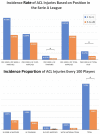Epidemiology of Anterior Cruciate Ligament Injury in Italian First Division Soccer Players
- PMID: 31800358
- PMCID: PMC7222666
- DOI: 10.1177/1941738119885642
Epidemiology of Anterior Cruciate Ligament Injury in Italian First Division Soccer Players
Abstract
Background: The burden of anterior cruciate ligament (ACL) injury in professional soccer players is particularly relevant as it represents a potentially career-threatening injury.
Hypothesis: Our hypotheses were that (1) injury incidence rate would be similar to that reported in the literature, (2) we would identify a uniform distribution of the injuries along the season, and (3) injury incidence rate would be similar in high-ranked and lower ranked teams, based on final placement in the league.
Study design: Descriptive epidemiological study.
Level of evidence: Level 4.
Methods: Professional male soccer players participating in the Serie A championship league in 7 consecutive seasons (2011-2012 to 2017-2018) were screened to identify ACL injuries through the online football archive transfermarkt.com . Exposure in matches and training were calculated.
Results: There were 84 ACL injuries found (mean player age, 25.3 ± 4.2 years). Overall, 25% of ACL injuries were reruptures (15%) or contralateral injuries (10%). ACL incidence rate was 0.4215 per 1000 hours of play during Serie A matches, 0.0305 per 1000 hours of training (rate ratio [RR], 13.8; 95% CI, 8.4-22.7; P < 0.0001), and 0.0618 per 1000 hours of total play. Injury distribution had a bimodal peak, with the highest number of events in October and March. Alternatively, training injuries peaked in June and July. A significantly higher incidence rate was found for the teams ranked from 1st to 4th place compared with those ranked 5th to 20th (0.1256 vs 0.0559 per 1000 hours of play; RR, 2.2; 95% CI, 1.4-3.6; P = 0.0003). A similar finding was found for injury incidence proportion (3.76% vs 1.64%; P = 0.0003).
Conclusion: The overall incidence rate of ACL injuries in Italian Serie A was 0.062 per 1000 hours, with a 14-fold risk in matches compared with training. Relevantly, 25% were second injuries. Most injuries occurred in October and March, and an almost 2-fold incidence rate and incidence proportion were noted in those teams ranked in the first 4 positions of the championship league.
Clinical relevance: Knowing the precise epidemiology of ACL injury in one of the most competitive professional football championship leagues could help delineate fields of research aimed to investigate its risk factors.
Keywords: ACL; Serie A; anterior cruciate ligament; epidemiology; football (soccer); professional.
Conflict of interest statement
The authors report no potential conflicts of interest in the development and publication of this article.
Figures




References
-
- Agel J, Rockwood T, Klossner D. Collegiate ACL injury rates across 15 sports: National Collegiate Athletic Association Injury Surveillance System data update (2004-2005 through 2012-2013). Clin J Sport Med. 2016;26:518-523. - PubMed
-
- Amin NH, Old AB, Tabb LP, Garg R, Toossi N, Cerynik DL. Performance outcomes after repair of complete Achilles tendon ruptures in National Basketball Association players. Am J Sports Med. 2013;41:1864-1868. - PubMed
-
- Carling C, McCall A, Le Gall F, Dupont G. The impact of in-season national team soccer play on injury and player availability in a professional club. J Sports Sci. 2015;33:1751-1757. - PubMed
-
- Carling C, McCall A, Le Gall F, Dupont G. The impact of short periods of match congestion on injury risk and patterns in an elite football club. Br J Sports Med. 2016;50:764-768. - PubMed
MeSH terms
LinkOut - more resources
Full Text Sources
Research Materials

